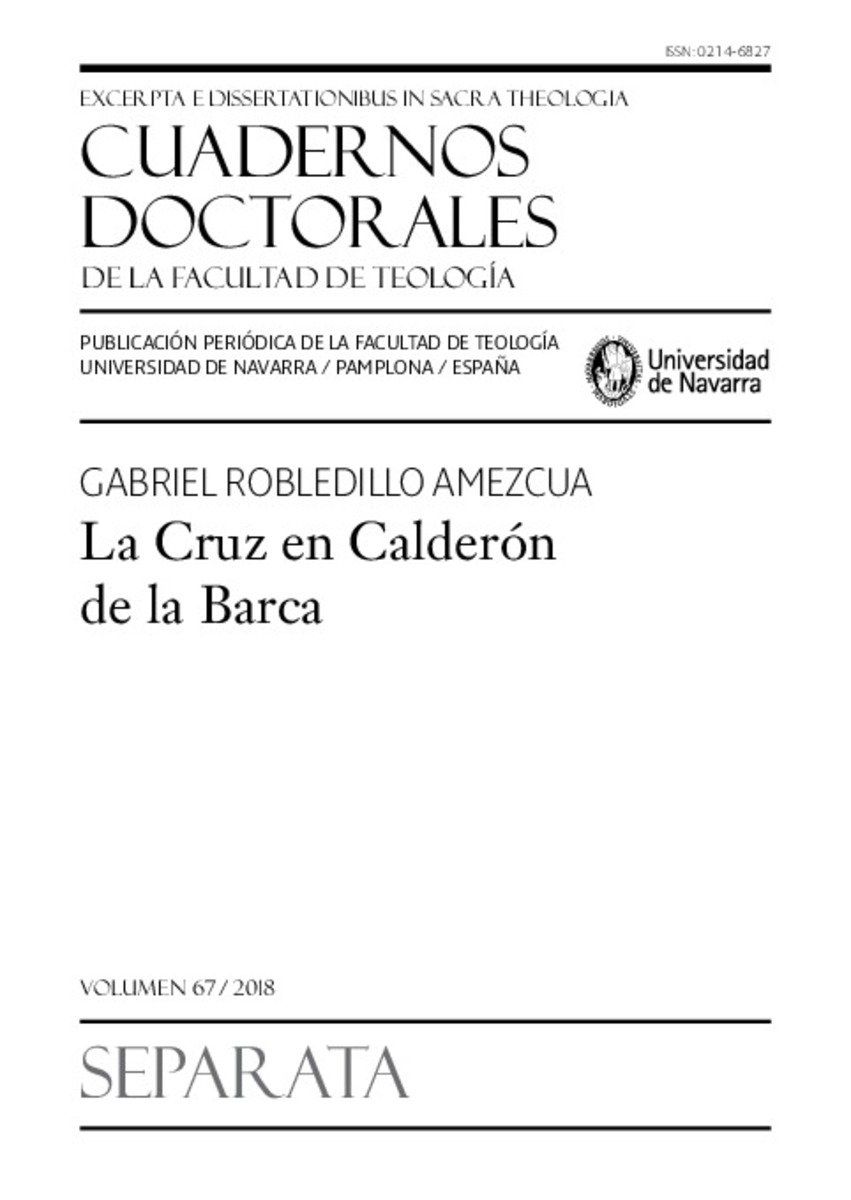Full metadata record
| DC Field | Value | Language |
|---|---|---|
| dc.creator | Robledillo-Amezcua, G. (Gabriel) | - |
| dc.date.accessioned | 2018-11-12T18:11:53Z | - |
| dc.date.available | 2018-11-12T18:11:53Z | - |
| dc.date.issued | 2018 | - |
| dc.identifier.citation | Robledillo-Amezcua, G. (Gabriel). "La Cruz en Calderón de la Barca". Cuadernos Doctorales de la Facultad de Teología. Excerpta e Dissertiationibus in Sacra Theologia. 67, 2018, 345 - 403 | es |
| dc.identifier.issn | 0214-6827 | - |
| dc.identifier.uri | https://hdl.handle.net/10171/55781 | - |
| dc.description.abstract | El objetivo de la tesis es ver cómo Pedro Calderón de la Barca trata la devoción de la cruz en dos obras de teatro: La devoción de la Cruz y La exaltación de la Cruz. La intencionalidad de Calderón al escribir teatro es dar a conocer a Dios, pedagogía religiosa, a la vez que forma religiosamente al público asistente, siguiendo las directrices teatrales de la Compañía de Jesús. Sus obras son una continua lucha para que sus personajes logren la salvación del alma. Calderón se hace eco del estilo artístico que acompaña el anhelo reformista en la Iglesia católica: el Barroco. Calderón, a través de sus obras, nos muestra las diferentes maneras de encontrar la cruz, que puede tener un cristiano. Don Pedro escribe su teatro para toda clase de público, todos tienen alma, y con la intención de dar a conocer a Dios y su doctrina. Todo ello apoyándose en la espiritualidad de la cruz, que en el Siglo de Oro está en pleno auge. «Si alguno quiere venir en pos de mí, niéguese a sí mismo, tome su cruz y sígame». (Mt 16, 24). | es_ES |
| dc.description.abstract | The objective of the thesis is to see how Pedro Calderón de la Barca treats the devotion of the cross in two of his plays: The devotion of the Cross and The exaltation of the Cross. The intentionality of Calderón when writing plays is to make God known, religious pedagogy, while at the same time he educates in the religious aspect to the audience that attend the plays, and follows the theatrical directives of the Society of Jesus. His works are a continuous battle in order that his characters may obtain the salvation of soul. Calderón echoes the artistic style that accompanies the reformist desire within the Catholic Church: this is the Baroque style. Through his works, Calderón shows us the different ways in which a Christian can find the cross. Don Pedro writes his plays addressing all audiences –everyone has a soul– with the intention of making God and his doctrine known. He does so by leaning in the spirituality of the cross, which at that time is in full swing. «If anyone wants to follow me, let him renounce himself, take up his cross, and follow me» (Matthew 16, 24). | es_ES |
| dc.language.iso | spa | es_ES |
| dc.publisher | Servicio de Publicaciones de la Universidad de Navarra | es_ES |
| dc.rights | info:eu-repo/semantics/openAccess | es_ES |
| dc.subject | Calderón de la Barca | es_ES |
| dc.subject | Teatro y Catequesis | es_ES |
| dc.subject | Cruz | es_ES |
| dc.subject | Theater and Catechesis | es_ES |
| dc.subject | Cross | es_ES |
| dc.title | La Cruz en Calderón de la Barca | es_ES |
| dc.type | info:eu-repo/semantics/article | es_ES |
| dc.publisher.place | Pamplona | es_ES |
| dadun.citation.endingPage | 403 | es_ES |
| dadun.citation.publicationName | Cuadernos Doctorales de la Facultad de Teología. Excerpta e Dissertiationibus in Sacra Theologia | es_ES |
| dadun.citation.startingPage | 345 | es_ES |
| dadun.citation.volume | 67 | es_ES |
Files in This Item:
Statistics and impact
Items in Dadun are protected by copyright, with all rights reserved, unless otherwise indicated.






